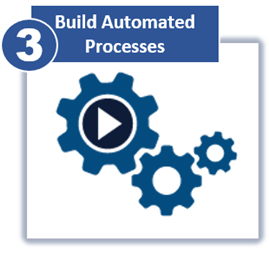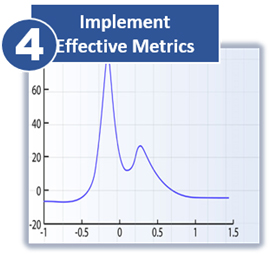Analytical Marketing
Section 1 – The Challenges
By David Bartenwerfer
As mentioned in the previous article in this sequence, Marketing owns the customer relationship and because of that is the most frequent gatherer of customer data, and therefore is the corporate function most impacted by the rise of data. This puts the Marketing organization in a leadership role in driving analytical thinking throughout the enterprise. Marketing must become the organization that captures, integrates and analyzes customer data.
Analytical Marketing – Five Steps
There are several steps that an organization needs to follow to transform their marketing group into one that collects, integrates and employs data to continuously learn and to produce better outcomes. Not surprisingly, the first step involves some deep thinking — planning the overall marketing strategy and its various sub-components. Then comes the heavy lifting in the form of selecting the right technology infrastructure and associated processes, and finally the fun and impactful part — the analytics.
One note: while this paper presents a series of steps, the true process will follow these steps but may cycle back in an iterative fashion as the organization learns and adjusts after each iteration.

One of the better definitions of strategy is the art and science of planning and marshalling resources for their most effective use; so, title of this section could also have been ‘get strategic’. But, since ‘Get Smart’ covers a little bit more ground let’s start with that.
One of the core principles of management theory is to ‘begin with the end in mind’, and organizations that use their collective smarts to envision their most productive and effective future will be rewarded with a vision that guides them through this process.
The first step in transforming a Marketing organization into one that is more analytically focused is to develop separate but interconnected strategies the consider each of the following dimensions: customer interactions, data, organization, technology, and analytics. Because these dimensions are inter-connected, each of their strategic plans must be consistent and in alignment with each other.

Modern marketing organizations are consumed with data right now, and Marketing leadership and their teams are wondering how to untangle the mess, how to bring some order and sense to it. There is a general feeling that the endgame has a certain look to it. The right data should be accessible — the right data being that which makes the organization more efficient, more effective, and more intelligent. And, that analytics should be applied to inform their marketing messages, to test new interaction strategies, and innovate in how their company engages with customers. But many Marketing Organizations are struggling with how to get there, how they can get control of their data to stop the proliferation of individual data silos given the constant influx and growth of information.
In order to get from the present to the desired future, one needs to know a) what that desired future looks like and b) have a plan to get there. This sounds obvious. This is strategy, in a simplistic sense. However, with changing markets, changing technology and changing human resources, the endgame is often a moving target and the path to get there is full of moving landmines. Therefore, technology strategies are often an iterative process.
So, under those conditions it’s best to have a strawman view of where you want to go and how to get there and then start with what you have and initiate pilot projects to get the ball rolling. In order to get the process started, marketers should a) evaluate their talent to move forward with a data-centric organization, b) understand the data they have now, c) work to open up the informational and organizational silos that keep that data isolated and d) define the vision for the future.


Professionals with technology- and process-oriented personalities don’t typically gravitate toward the profession of Marketing. So, it’s no surprise that marketers shun discussions of process and would much prefer to focus their efforts on more exciting initiatives like creating a great campaign or managing a successful product launch. However, in a digital world, it’s process automation that enables Marketing to collect the data that they need to perform the analytics required to outperform their competition.
There’s a field broadly referred to as Marketing Operations Management that refers to the technology that enables merging and streamlining internal and external marketing functions, including employees, channels, processes, data, and technologies. It’s the application(s) and associated workflows that provide a framework to systematically plan, manage, and execute marketing operations, including budgets, planning, and content management.
As the complexity of running a marketing department increases, automated processes become necessary to align the appropriate people with the right marketing tasks; enabling marketing organizations to improve time-to-market, allocate resources and perform closed loop marketing. Without well-defined processes for marketing, it is impossible to manage the complexity, measure marketing outcomes, and plan strategically. To better understand the automation of marketing processes one needs to understand the components of the technology vendors serving the marketing community.

Metrics are a powerful tool for informing and guiding decision making at all levels of an organization. Quantitative measurement of performance helps leaders monitor the health of the business, and focus resources on the areas of greatest value. Metrics range from the mandatory — for regulatory, safety or contractual reasons — to those that track efficiency, productivity, performance, revenues/costs/profits and other successes/failures.
Marketing metrics should support the strategies for all aspects of the organization; however, metrics can be detrimental if not designed and implemented properly. There are steps that marketing organizations can take to ensure the success of their metrics.
The use of metrics is constantly evolving as the volume of information accelerates and the opportunities to generate insights through data analytics is only as limited as the ability of your organization. More robust data from a broader array of sources coupled with new analytical tools to pull value from that data give organizations both more granular and more panoramic views of their business situation. All metrics should be clear so that there is no ambiguity either internal or external to the organization.

Just like the phrase Big Data, the practice of Analytics continues to gain more attention in board rooms. In the context of marketing, analytics promises to transform the way companies engage with customers. As companies get more savvy about employing data and analytics to make better decisions, having the ability to generate insights using complex mathematical methods will become an increasingly crucial point of competitive differentiation.
Marketing organizations can take full advantage of the benefits of data and analytics if they have laid the groundwork outlined in the articles that follow. At this stage, they have thoughtfully considered their data and analytics strategy, are working toward procuring and managing that data, have made the investments to automate their processes, and developed the right metrics. The final piece of this puzzle is developing the capability to build advanced analytics models for predicting and optimizing outcomes.
Returning to the Big Data theme, organizations should understand that the real issue isn’t that your organization is acquiring large amounts of data, it’s what you’re doing with the data that matters. The vision for marketing organizations is that they will be able to take data from any source, harness that data with analytics and find insights that enable cost or time reductions, increased customer acquisition, reduced customer attrition, optimized new product development offerings, and in general, smarter business decisions. Some examples of how marketing organizations can combine data and analytics:
- identify customers who matter the most;
- score the value of leads to predict their future value appropriately allocating the right lead to the right vehicle for responding to that lead;
- determine root causes of failures like customer defections and anticipate the impact of improvements to those metrics to revenues and profits;
- drive revenue by generating retail coupons at the point of sale based on a customer’s current or past purchases;
- analyze pricing and customer reaction to determine the pricing strategy and tactics that maximize profit and clear inventory;
- experiment with different strategies across geographies, customer segments and products;
- determine the ROI of their marketing programs and optimize the mix of investments across all marketing objectives.
All these examples, as well as countless other potential approaches, will have a marked impact on the competitive position and profitability of the company that employs them.
Link to the next article in the sequence: Analytical Marketing 2.1 – Get Smart
Author
David Bartenwerfer is the founder and principal of Quantum Consulting and Technology. QuantumCT helps product and marketing organizations get smarter and prove, predict and optimize impact and ROI with economic and financial modeling that employs customizable algorithms and technology leading to fast and lasting insight and action. Mr. Bartenwerfer has over twenty years’ experience in the High Tech, Internet, Telecom, Media, Financial Services and Retail industries and holds a B.S. in Systems Engineering with minors in applied mathematics and economics from the University of Virginia and an M.B.A. from the Stanford Graduate School of Business. For further information, contact the author at davidbartenwerfer@quantumct.com .